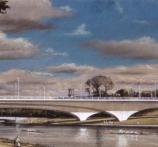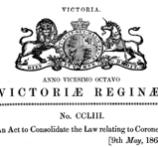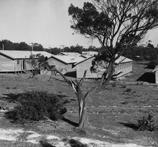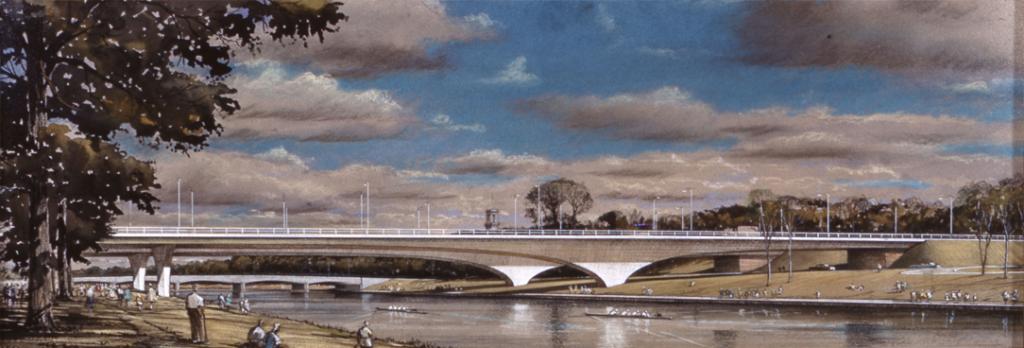Last updated:
Refereed articles

Community opposition to inner urban arterial roads in the 1970s
Expand SummaryThis article explores community resistance to the F2 freeway proposal that emerged in the wake of the 1969 Melbourne Transportation plan. Drawing on published work in urban social history and urban policy analysis, as well as a wide range of archival sources, it provides an account of the defeat of this freeway proposal through community protest and the exertion of political pressure on government. It argues that the defeated proposal had been generated as part of a broader road-building consensus in Melbourne that gave little consideration to community impacts and the possibility of alternative transport solutions—a consensus that largely survives to the present day despite occasional backdowns such as the one explored in this article.
![Great Western Hotel, Temple Court Hotel and Assay Office in a detail taken from the PROV version of the Bibbs map, VPRS 8168/P3 Historic Plan Collection, Unit 46, MELBRL 12 Melbourne: [Melbourne. n.d.].](/sites/default/files/styles/thumbnail_158x147/public/files/MinchintonB-F05_th.jpg?itok=_ztZf1I3)
Who made it, when and why?
Expand SummaryThe Bibbs map is employed by Melbourne’s urban archaeologists to decode the remains of the city’s gold rush era building fabric, but it has been dated differently by different researchers. There are two known copies of the plan in existence, one held by Public Record Office Victoria (PROV) and the other by the Melbourne City Council. This article argues that the two maps were produced at different times for different purposes, but the survey on which they were based was completed in the first half of 1856 in order to facilitate the implementation of Melbourne’s reticulated water supply. The plan is one of a number in the Historic Plan Collection at PROV providing valuable background information for heritage research.

Place, kin and culture in coronial inquests
Expand SummaryThis article explores the utility of using the rich holdings of coronial inquests in the collection of Public Record Office Victoria as fertile sources for exploring histories of place, kin and culture. It suggests ways in which the minutiae of everyday life contained in inquest deposition files provide a unique source enabling the historian to tell stories about ways of life as much as the circumstances of death. Coronial inquiries were established in the British legal tradition, with hotels playing an important early role in both the housing of dead bodies and the holding of inquests. The article further explores a range of examples under the themes of work, place, family and race to analyse the value of inquest files in understanding the experience of individual workers against the backdrop of occupational categories, to research fine-grained local histories, to disrupt racial stereotypes, and to understand family dynamics and extended relationships. These case studies throw light on a range of methodological and ethical issues pertinent to this genre of record, revealing inquest records as a complex body of important public documents with personal sensitivities, both for the historian and their subject.

The nature of Aboriginal people’s use, indeed occupation, of the Victorian Mallee ‘back country’ warrants detailed investigation. Probably arising out of the paucity of observations of Aboriginal people on the land before it was pastorally occupied, an historical analysis from the 1870s suggesting Aboriginal people were not occupiers but mere ‘seasonal visitors’ to the ‘back country’ was unquestionably accepted for the next century. Growing understanding of the fundamentally sophisticated ways in which Aboriginal people managed their land has led to some recent historical works with a revised understanding of land use in the ‘back country’, but there is no agreement to move away from the orthodox historical paradigm.
Parish plans from the Mallee, part of PROV’s ‘Parish and township plans’ collection, were investigated to determine whether they contain evidence of former Aboriginal land use that could inform this question. It was found that these plans can potentially reveal the presence of pre-colonial Aboriginal water management, pathways, quarries, land management, cemeteries and placenames. Thus, parish plans were shown to be a potentially valuable resource that might have the capacity to support a reinvestigation of Aboriginal land use in the ‘back country’. Approaches for a more detailed investigation of the value of these plans are suggested.
Forum articles

Insights from inquest depositions and minding the gaps
Expand SummaryDrawing on the common thread of Elizabeth Morgan’s appearance as a deponent in her father’s and daughter’s inquests (1861 and 1870), this article examines how inquest depositions can be mined for evidence of familial relationships and circumstances. It considers what other records and research strategies can support the interpretation (and absence) of inquest records, and what insights can be gained from minding the gaps in the narratives offered.
![The extraordinarily imaginative Garden of the Moon tourist folly at Arthurs Seat on the Mornington Peninsula (constructed c. 1939) was one of Lawson’s final designs. It encapsulated Lawson’s belief in the importance of leisure via architectural fantasy. Rose Stereograph Company, The Garden of the Moon, Hollywood, Arthurs Seat, Vic., [c. 1940s], State Library of Victoria, Pictures Collection, H32492/362](/sites/default/files/styles/thumbnail_158x147/public/files/BlueVC-F02_th.jpg?itok=xyu7eVqK)
The architect who built
Expand SummaryThis article explores some of the myths surrounding the early twentieth-century Victorian architect, Howard R Lawson. Known today as the eclectic architect who designed the highly dramatic Beverley Hills flats at South Yarra (c. 1935–1936), his reputation has suffered over the decades due to misinformation and a misunderstanding of events. He was, in fact, a very progressive architect, with a keen interest in bettering lives through considered town planning and thoughtful design. Lawson utilised recycled materials well before it was considered to be fashionable or desirable, and was an early pioneer of building conversions in 1912, many decades ahead of his time.

In March 1946, the war was over. The Italian prisoners of war who had been captured several years earlier in northern Africa were interned in camps around Australia and were waiting to be returned home. One Saturday evening, the commandant of the Rowville internment camp, Captain Waterston, shot and killed a prisoner, Rodolfo Bartoli, who he claimed was attempting to escape. What initially appeared to be a straightforward case of an Australian army officer carrying out his duty in an attempt to prevent an Italian prisoner from escaping soon appeared to be something other. Allegations of assaults, reckless firing of weapons, drunkenness and stolen goods began to emerge. This article explores the history of the camp and follows the investigations into the shooting and the camp administration.
Material in the Public Record Office Victoria archival collection contains words and descriptions that reflect attitudes and government policies at different times which may be insensitive and upsetting
Aboriginal and Torres Strait Islander Peoples should be aware the collection and website may contain images, voices and names of deceased persons.
PROV provides advice to researchers wishing to access, publish or re-use records about Aboriginal Peoples
